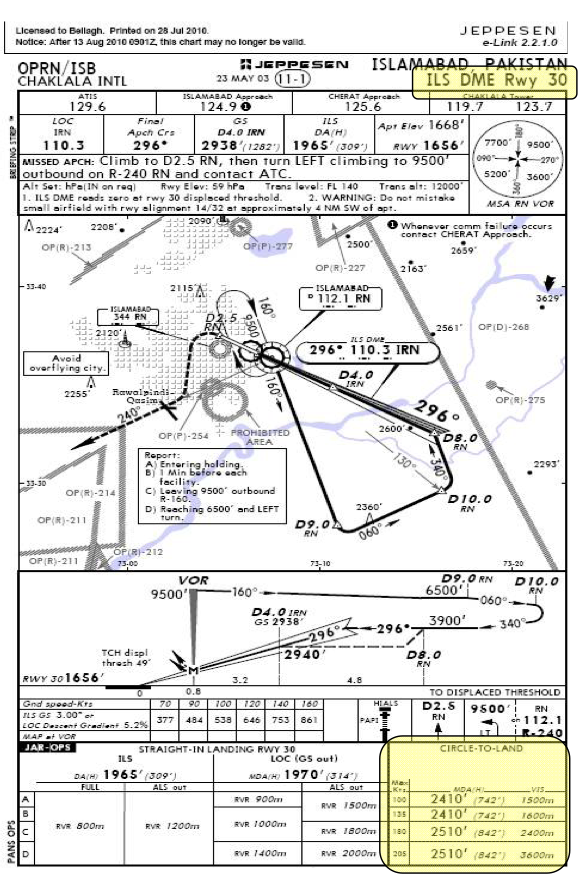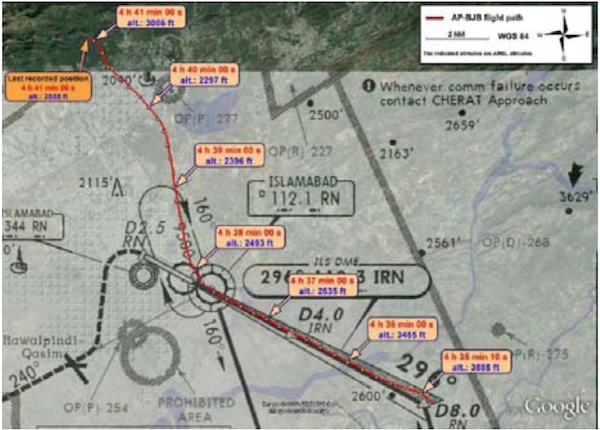The safety investigation board goes through 21 pages of aircraft systems, company procedures, and geography which basically point to the fact the captain ignored all of it when designing his own FMS circling approach and flying his aircraft into the side of a mountain. So was this a classic CFIT? Or perhaps a problem with circling approach procedure?
— James Albright

Updated:
2021-00-00
No, the crux of the problem is revealed in chapter 8:
- During initial climb, the Captain tested the knowledge of FO and used harsh words and snobbish tone, contrary to the company procedures/norms.
- The question / answer sessions, lecturing and advises by the mishap Captain continued with intervals for about one hour after takeoff.
- After the intermittent humiliating sessions, the FO generally remained quiet, became under confident, submissive, and subsequently did not challenge the Captain for any of his errors, breaches and violations.
While the first officer complied with the captain's instructions to build the illegal approach and dialed in the requested altitudes, he did weakly warn the captain after several (21) EGPWS alerts, "Sir pull up, sir."
The report relates what really happened but their "primary cause" was listed as violation of established procedures for a visual approach and failure to heed EGPWS warnings. All that is true, but in my view, the lessons to be learned from this are:
- You have to foster an environment on the flight deck where everyone is able to provide input, it does no good to shut a crew member down.
- You should not build a circling approach into the FMS.
- If you lose sight of the runway while circling, climb and go missed.

1
Accident report
- Date: 28 July 2010
- Time: 09:41
- Type: Airbus A321-231
- Operator: Air Blue
- Registration: AP-BJB
- Fatalities: 6 of 6 crew, 146 of 146 passengers
- Aircraft Fate: Destroyed
- Phase: Approach
- Airports: (Departure) Karachi International Airport (KHI/OPKC), Pakistan; (Destination) Islamabad-Benazir Bhutto International Airport (ISB/OPRN), Pakistan
2
Narrative
ABQ-202, mishap aircraft A-321, AP-BJB, on 28 July 2010, operated by Airblue was scheduled to fly a domestic flight sector Karachi - Islamabad. The aircraft had 152 persons on board, including six crew members. The Captain of aircraft was Captain Pervez Iqbal Chaudhary. Mishap aircraft took-off from Karachi at 0241 UTC (0741 PST) for Islamabad. At time 0441:08, while executing a circling approach for RWY-12 at Islamabad, it flew into Margalla Hills, and crashed at a distance of 9.6 NM, on a radial 334 from Islamabad VOR. The aircraft was completely destroyed and all souls on board the aircraft, sustained fatal injuries. May Allah bless their souls.
Source: Pakistan Civil Aviation Authority Safety Investigation Board, page 3
- The mishap crew had listened to the Automatic Terminal Information Service (ATIS) information at about 0350 UTC and were informed that the runway in use at Islamabad airport (OPRN) was RWY-12.
- After learning that ABQ-202 would be required to execute a visual circling approach for RWY-12, in the reduced visibility and low clouds, Captain prepared himself to fly the visual circling approach on NAV mode.
- Accordingly, the Captain asked the FO to feed unauthorized 04 waypoints (PBD 8 to 11) in the FMS. FO did not challenge the Captain for his incorrect actions.
- While planning for right hand downwind of visual approach RWY-12, at 0357:48 the Captain briefed First Officer (FO), "from abeam RWY-30, 3 to 5 miles abeam CF, then we go to abeam CF and then landing". This was contrary to established procedures for BBIAP, Islamabad.
- During the descent, the Captain's request for a right hand D/W RWY-12 for a visual approach (the request being contrary to established procedures at BBIAP) was not agreed to by the Radar due to procedural limitations. The Captain became worried about bad weather and low clouds on the left hand downwind.
Source: Pakistan Civil Aviation Authority Safety Investigation Board, chapter 8
It is unclear why the captain wanted to fly a right downwind pattern. The terrain to the west is higher, there is a prohibited area just two miles west, and there is a city with an "avoid" note.
- The Radar Controller informed ABQ-202 to "expect arrival to ILS RWY-30 circle to land RWY-12". The FO then requested a "right downwind RWY-12 for the approach". The controller responded that "right downwind RWY-12 is not available at the moment because of low clouds". Captain acknowledged "We understand right downwind is not available, it will be ILS down to minima and then left downwind ok".
- At 0436:20, the crew again asked ATC Tower "how's the weather right downwind" The tower controller responded that the right downwind was not available and that only left downwind for RWY-12 was available.
- At 0436:33 the Captain wanted to descend to 2,000 ft, but was reminded by FO of 2,500 ft (MDA), indicating possible intentions of Captain.
- At 0437:03, the crew leveled the aircraft at an altitude of 2,500 ft., autopilot 2 was disengaged and the crew flew the aircraft on a constant heading until the RN VOR with only autopilot 1 engaged.
- At 0437:26, the confirmation by the Tower for the safe landing of PK-356 (aircraft of a competitive airline) in the same weather conditions put the Captain under further pressure to ensure a landing at Islamabad under any circumstances.
- At 0437:27, the break-off to the right, after the ILS approach was delayed due to late visual with the airfield caused by poor visibility. ATC also called visual with AB-202 and asked AB-202 to report established left D/W RWY-12.
- At 0437:32 as the aircraft was flying over the RN VOR, the crew commanded a right turn through the autopilot. A few seconds later, the selected altitude was lowered to 2,300 ft and the aircraft started to descend to selected altitude, thus violating the height minima of 2,510 MDA.
- At 0437:36, the Captain asked FO to activate secondary flight plan, which was activated in the FMS.
- After break-off from ILS approach, the Captain ignored the tower controller's suggestion (at 0437:54) to fly a bad weather circuit by saying "let him say whatever he wants to say". The CVR recording and flight simulation show that the Captain probably decided to fly a managed approach on pre selected PBDs unbeknown to the ATS.
- At time 0438:01, although Captain said that he was going for NAV, yet the aircraft kept on flying on HDG mode. FO reminded "Okay Sir, but are you visual?" The Captain said "Visual Hein! OK".
- At 0438:47, the Captain while preparing for intended approach pattern, said to FO "passing (waypoint) "PBD11" they would take flaps 3 and Flaps full".
- At 0439:32 as the aircraft was more than 3.5 NM from the runway centerline; abeam the threshold of RWY-12 with a heading of 352°, the crew commanded a left turn to 300° through the autopilot.
Source: Pakistan Civil Aviation Authority Safety Investigation Board, chapter 8
While this may seem quite wide compared to the TERPS criteria used on most U.S. circling approaches, it is within ICAO radii and updated TERPS rules.
More about this: Circling Approach Area.
Source: Pakistan Civil Aviation Authority Safety Investigation Board, chapter 8
- At 0439:43, lateral mode was changed to NAV (which continued till 0440:28 hrs.)
- At 0439:46 as the aircraft was 01 NM to the south of prohibited area OP (P) - 277, the air traffic controller instructed the crew to turn left in order to avoid a No-Fly Zone (NFZ).
- At 0439:58, the aircraft was 5 NM to the north of the aerodrome and the first EGPWS predictive "TERRAIN AHEAD" caution was recorded on the CVR. FO told the captain "this Sir higher ground has reached, Sir there is a terrain ahead, sir turn left".
- By now the Captain had become very jittery in his verbal communication and displayed frustration, confusion and anxiety resulting in further deterioration in his behaviour.
- At 0440:10, tower controller asked the crew if they were visual with the airfield. The crew did not respond to the question, whereas, FO asked the Captain (on cockpit Mic) "Kia batauon Sir ?" (What should I tell him Sir?)
- Immediately at 0440:16 on the insistence of Radar Controller, the Tower Controller asked the crew if they were visual with the ground. Captain and the FO responded to the controller "Airblue 202 visual with the ground". FO again asked Captain "Sir terrain ahead is coming". The Captain replied "Han ji, we are turning left" (Yes, we are turning left). Whereas aircraft was not turning, only the HDG bug was being rotated towards left. At the same time, two EGPWS predictive "TERRAIN AHEAD" cautions were recorded on the CVR.
- The pilots were unsure of their geographical position and did not seek Radar help. The consequent loss of situational awareness caused the aircraft to go astray.
- In an attempt to turn the aircraft to the left, the Captain was setting the heading bug on reduced headings, but not pulling the HDG knob. Since the aircraft was in the NAV mode, the Captain was not performing the appropriate actions to turn the aircraft to the left.
Source: Pakistan Civil Aviation Authority Safety Investigation Board, chapter 8
Pilots of automated cockpits should get in the habit of always ensuring the aircraft reacts as expected whenever making a change to the flight management system, flight director, and autothrottles. Never make an input and move on without doing this first.
More about this: CFIT / Confirm FMS Changes.
- At 0440:28, lateral mode was changed from NAV to HDG, 40 Seconds before the impact. At this stage, current heading of aircraft was 307 degrees, whereas selected heading had been reduced to 086 degrees, due to which the aircraft started to turn the shortest way to the right towards Margalla hills by default. From that time onward, several EGPWS predictive "TERRAIN AHEAD PULL UP" warnings were recorded on the CVR until the end of the flight.
- The high rate of descend at very low altitude could not be arrested and the aircraft flew into the hill and was completely destroyed. All souls on board sustained fatal injuries due to impact forces.
- At 0441:08, the FDR and CVR recordings ended. The aircraft struck Margalla Hills, 9.6 NM North-Northeast of BBIAP Islamabad VOR while executing circling approach for RWY-12 in a slight nose-down and high left bank attitude, with a descent rate greater than 3,000 ft/min. The elevation of the accident site was 2,858 ft, impact position: N33°44'39.6'', E073°02'36.5''.
Source: Pakistan Civil Aviation Authority Safety Investigation Board, chapter 8
4
Cause
Air blue crash has been finalized as a case of Controlled Flight into Terrain (CFIT), in which aircrew failed to display superior judgment and professional skills in a self created unsafe environment. In their pursuit to land in inclement weather, they committed serious violations of procedures and breaches of flying discipline, which put the aircraft in an unsafe condition over dangerous terrain at low altitude.
Source: Pakistan Civil Aviation Authority Safety Investigation Board, chapter 12
References
(Source material)
Pakistan Civil Aviation Authority Safety Investigation Board, Air Blue Flight ABQ-202 REG AP-BJB Pakistan Crashed on 28 July 2010 at Margalla Hills, Islamabad

